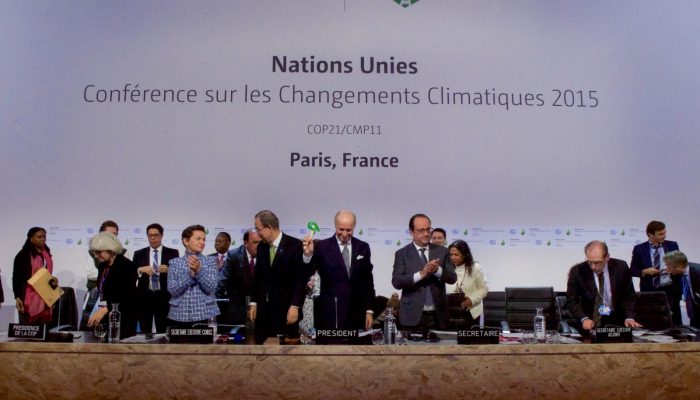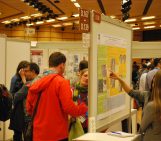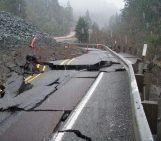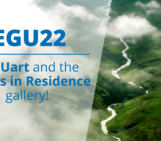
Drawing inspiration from popular stories on our social media channels, as well as unique and quirky research news, this monthly column aims to bring you the best of the Earth and planetary sciences from around the web.
Major Story
In the last couple of weeks of May, the news world was abuzz with the possibility of Donald Trump withdrawing from the Paris Agreement. Though the announcement actually came on June 1st, we’ve chosen to feature it in this round-up as it’s so timely and has dominated headlines throughout May and June.
In withdrawing from the agreement, the United States becomes only one of three countries in rejecting the accord, as this map shows. The implications of the U.S joining Syria and Nicaragua (though, to be clear, their reasons for not signing are hugely different to those which have motivated the U.S withdrawal) in dismissing the landmark agreement have been widely covered in the media.
President Trump’s announcement has drawn widespread condemnation across the financial, political and environmental sectors. Elon Musk, Tesla and SpaceX CEO, was one of many in the business sector to express their criticism of the President’s decision. In response to the announcement, Musk tweeted he was standing down from his duties as adviser to a number of White House councils. While in early May, thirty business CEOs wrote an open letter published in the Wall Street Journal to express their “strong support for the U.S. remaining in the Paris Climate Agreement.”
In a defiant move, U.S. States (including California, New York and Vermont), cities and business plan to come together to continue to work towards meeting the targets and plans set out by the Paris Agreement. The group, coordinated by former New York City mayor Mark Bloomberg, aims to negotiate with the United Nations to have its contributions accepted to the Agreement alongside those of signatory nations.
“We’re going to do everything America would have done if it had stayed committed,” Bloomberg, said in an interview.
Scientist and learned societies have also been vocal in expressing their criticism of the White House decision. Both Nature and Science collected reactions from researchers around the globe. The EGU, as well as the American Geophysical Union, and many in the broader research community oppose the U.S. President’s decision.
“The EGU is committed to supporting the integrity of its scientific community and the science that it undertakes,” said the EGU’s President, Jonathan Bamber.
For an in-depth round-up of the global reaction take a look at this resource.
What you might have missed
This month’s links you might have missed take us on a journey through the Earth. Let’s start deep in the planet’s interior.
The core generates the Earth’s magnetic field. Periodically, the magnetic field reverses, but what caused it to do so? Well, there are several, competing, ideas which might explain why. Recently, one of them gained a bit more traction. By studying the seismic signals from powerful earthquakes, researchers at the University of Oxford found that regions on top of the Earth’s core sometimes behave like a giant lava lamp. It turns out that blobs of rock periodically rise and fall deep inside our planet. This could affect the magnetic field and cause it to flip.
Meanwhile, at the planet’s surface, the Earth’s outer solid layer (the crust) and upper layer of the molten mantle, are broken up into a jigsaw of moving plates which pull apart and collide, generating earthquakes, driving volcanic eruptions and raising mountains. But the jury is still out as to when and how plate tectonics started. The Earth is so efficient at recycling and generating new crustal material, through plate tectonics, that only a limited record of very old rocks remains making it very hard to decipher the mystery. A recently published article explores what we know and what yet remains to be discovered when it comes to plate tectonics.

Tectonic plate boundaries. By Jose F. Vigil. USGS [Public domain], distributed by Wikimedia Commons.
Links we liked
- Earth Art takes a whole new meaning when viewed from space. This collection of photographs of natural parks as seen from above is pretty special.
- This round-up is usually reserved for non-EGU related news stories, but given these interviews with female geoscientists featured in our second most popular tweet of the month, it is definitely worth a share: Conversations on being a women in geoscience – perspectives on what being a female in the Earth sciences.
- We’ve shared these previously, but they are so great, we thought we’d highlight them again! Jill Pelto, a scientist studying the Antarctic Ice Sheet and an artist, uses data in her watercolous to communicate information about extreme environmental issues to a broad audience.
The EGU story
Temperatures in the Arctic are increasing twice as fast as in the rest of the globe, while the Antarctic is warming at a much slower rate. A new study published in Earth System Dynamics, an EGU open access journal, shows that land height could be a “game changer” when it comes to explaining why temperatures are rising at such different rates in the two regions. Read the full press release for all the details, or check out the brief explainer video, which you can also watch on our YouTube channel.
And don’t forget! To stay abreast of all the EGU’s events and activities, from highlighting papers published in our open access journals to providing news relating to EGU’s scientific divisions and meetings, including the General Assembly, subscribe to receive our monthly newsletter.




